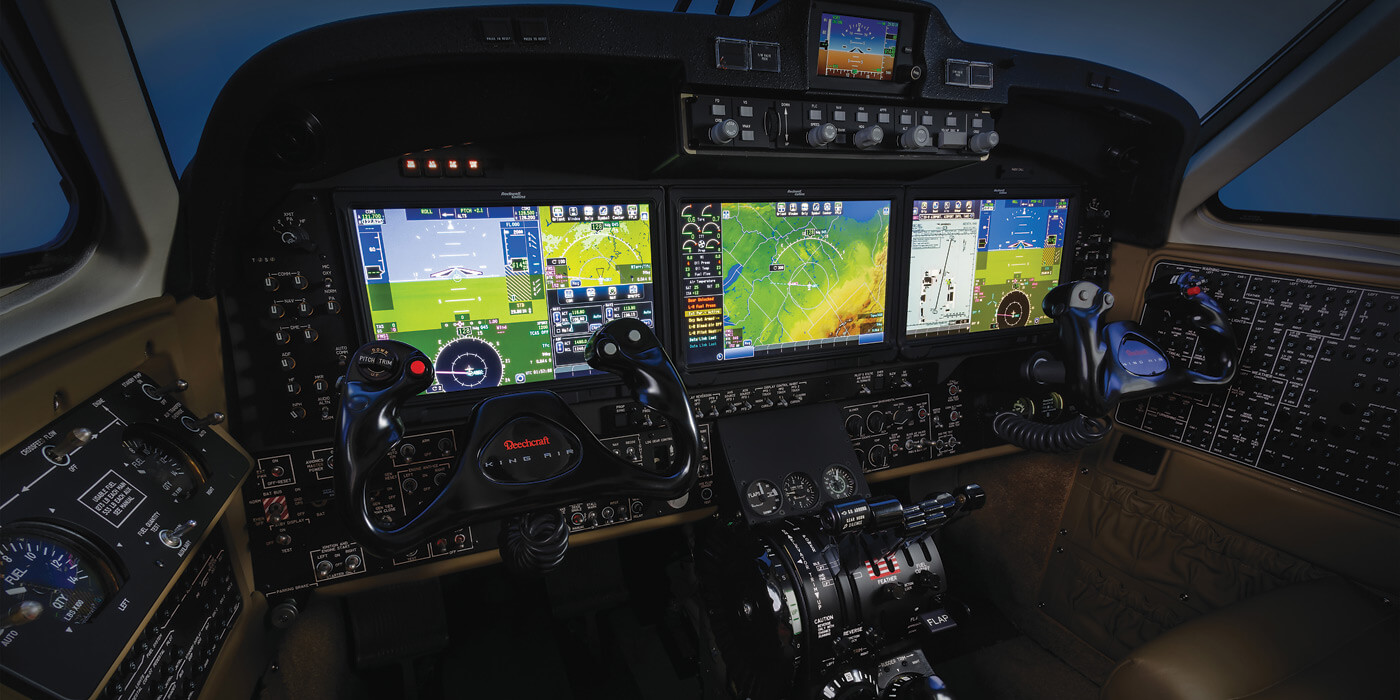Estimated reading time 8 minutes, 17 seconds.
The merits of the King Air aircraft line are hardly news. Beechcraft, now under Textron’s corporate stewardship, has sold over 7,000 of the iconic turboprop twins since the Model 90 was introduced in 1964. Skies featured a pilot report on the King Air 350i in October 2012 and found it a mature design with terrific utility.
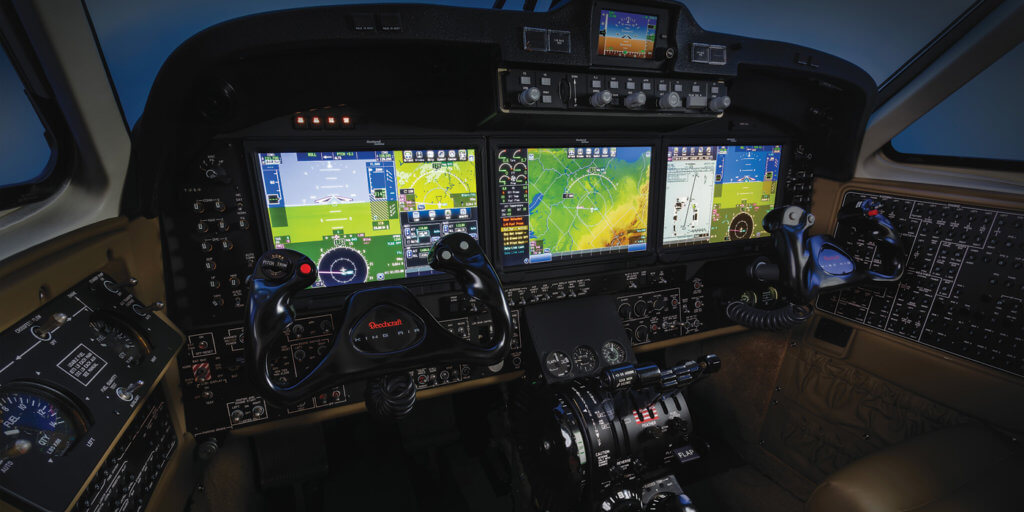
But something is new with the King Air: touch avionics. Now featuring the Rockwell Collins Pro Line Fusion avionics system, the King Airs currently have the only touchscreen primary and multifunction displays on a business aircraft.
Touch technology is ubiquitous. I imagine that every pilot who has ever used an iPad has shaken his head in dismay about the comparative “state-of-the-art” in avionics. We’ve grown accustomed to poking, pinching, zooming and swiping displays, yet those capabilities didn’t find their way into our cockpits. Apparently, that has changed.
Textron’s demonstrator aircraft, King Air 350i registration N1041F, brought its new avionics to Ottawa International Airport on a sunny August day. I flew with Textron demonstration pilot Nathan Schrag. To evaluate the touch avionics, we planned a round-robin flight to Montreal’s Mirabel Airport with an instrument approach at each end.
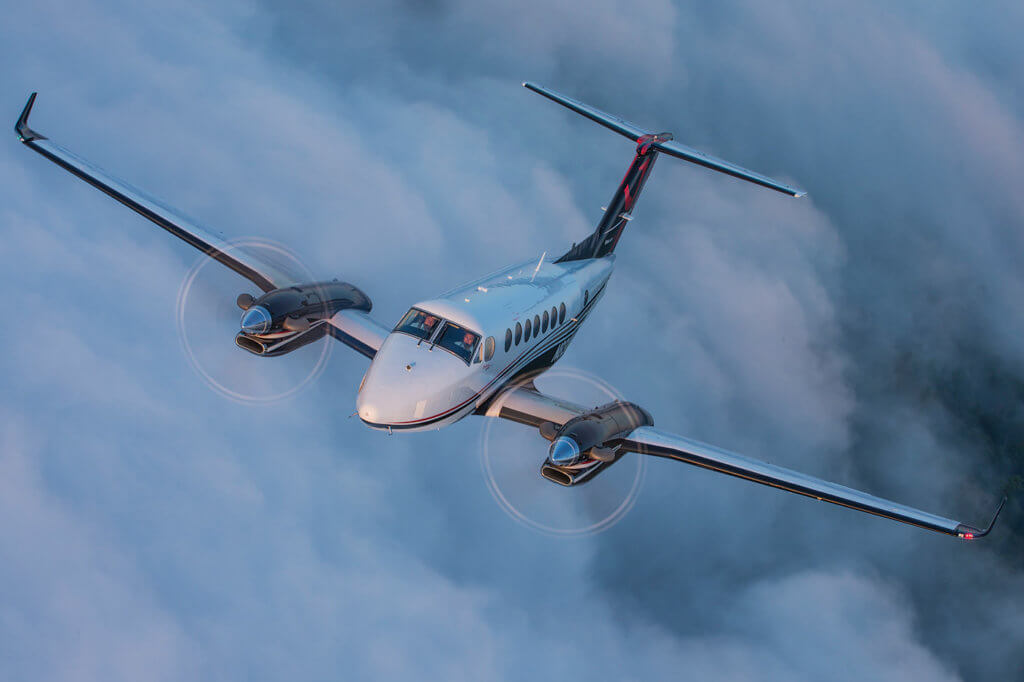
First impressions of the new King Air 350i cockpit were a study in contrasts. The most recent “clean sheet of paper” airplane designs eschew knobs and switches for an almost entirely digital interface. Not so the King Air. It exemplifies the challenges of integrating modern avionics into a legacy airframe; retaining the time-proven and familiar assortment of controls and gauges, whilst adding three bright, beautiful 14.1-inch displays.
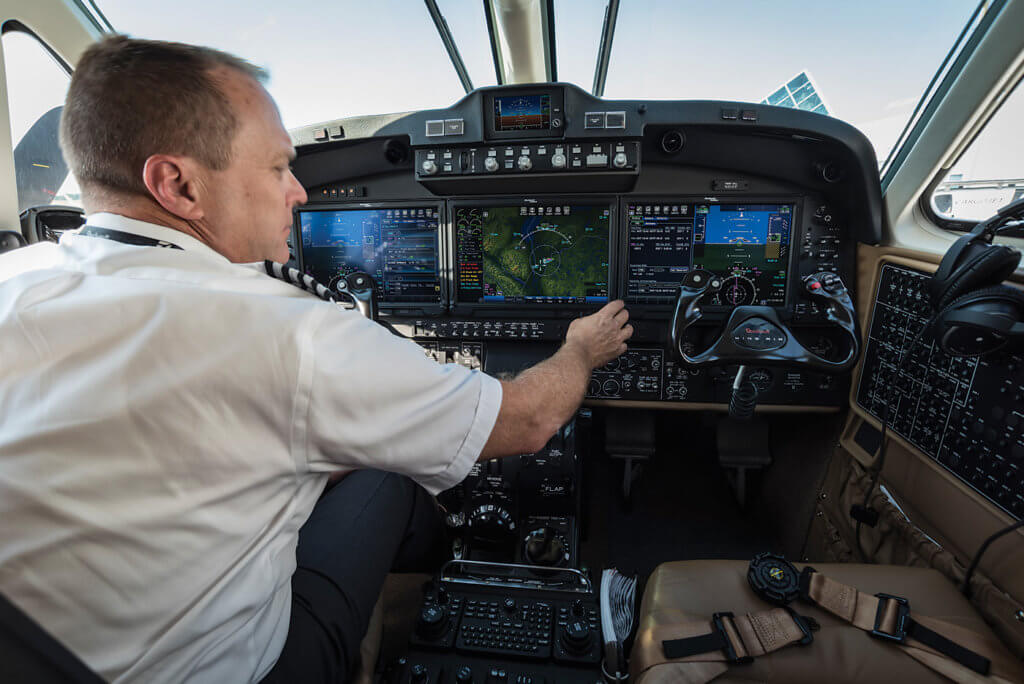
Arranged in landscape orientation, the displays almost filled the width of the cockpit. Missing from a conventional electronic flight deck are such items as control display units (CDUs) and radio tuning units (RTUs). The interface now consists of the displays themselves, supplemented by a cursor control panel (CCP) for each pilot, a QWERTY keyboard and a sprinkling of dedicated knobs and buttons.
QWERTY is an interesting choice, as it denotes a departure of design philosophy from conventional flight management system (FMS) CDUs that use ABC-123 keypads in closer alignment with familiar consumer electronics that we use in our regular lives. There is even an “escape” key, familiar to any desktop computer user, which closes a pop-up box and cancels the entry in progress. Cue the applause.
Schrag made quick work of the start-up procedures, then when it was time to initialize our flight plan he gestured that I was free to take a stab at it. Let’s see… normally this would involve entering data into the FMS. It so happened that the quick-access buttons on the top of the multi-function display included one labelled “FMS.” I poked it.
A window popped up with the invitation to “PLAN” our flight. I was on a roll! I entered the Ottawa airport identifier, CYOW, using the keyboard, then cut-and-pasted it from the scratchpad into the departure airport field. The process was not yet fully graphical, but straightforward nonetheless. The system cued me to enter our route, departure and arrival procedures and planned approaches. Once complete I hazarded a press of the “EXEC” button and the routing appeared on the moving map. Voila!
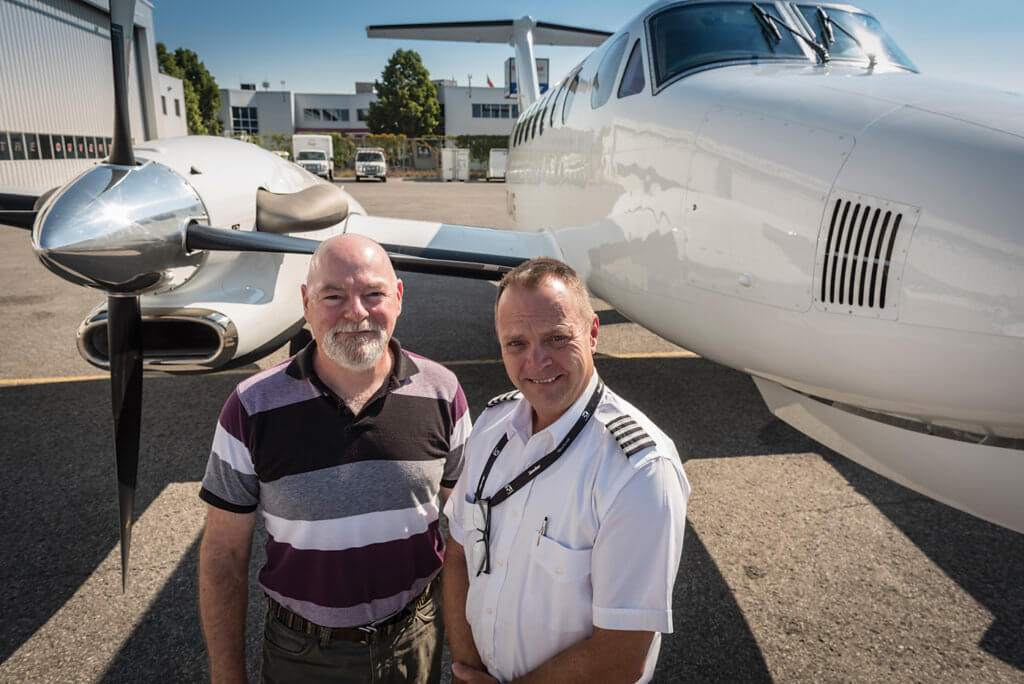
Despite so much technology in evidence, the start-up and preflight procedures were classic King Air. Schrag used the electronic checklists to guide him through the various checks that turboprops demand: pressurization, autopilot, engine governors and autofeather systems. In short order, we were ready to go. Touch displays certainly made things easier. For example, tapping the bottom of the airspeed tape called up a box for entry of our V-speeds.
Immediately upon departure from Ottawa’s Runway 25, I engaged the autopilot and sat back to assess the avionics. The Fusion primary flight display is state-of-the-art, including synthetic vision, a velocity vector and a speed command bar. I found it clear and easily interpreted. The display format is eminently flexible, and Schrag showed me how to configure each display with my preference of full, half or quarter screen windows.
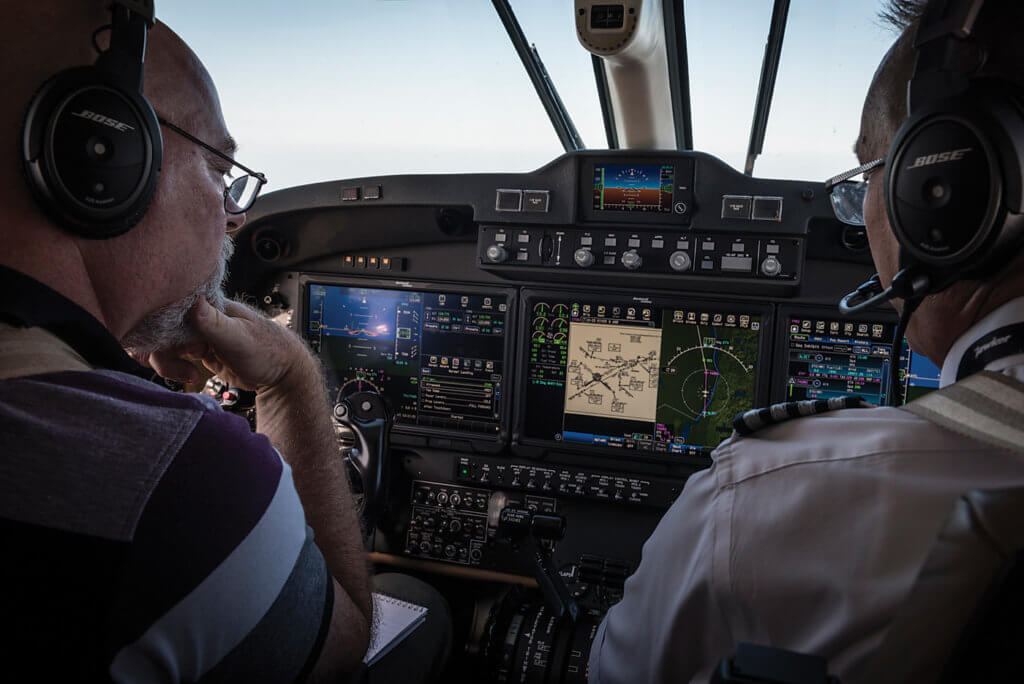
I quickly caught on to the interface, and began happily poking the displays, although slowed by a mildly annoying actuation time delay from touch to response. The displays utilize resistive, rather than the capacitive touch technology normally found on tablets and smartphones. Consequently, a pleasantly firm touch is required to activate the screen, which is confirmed with a synthetic audible click. Resistive touch displays also allow pilots to wear gloves.
A common concern about a touch interface is the influence of turbulence upon the trajectory of one’s index finger. Flying Mirabel’s RNAV 29 instrument approach on a hot summer day was a good test. With so much display real estate, a hand rest isn’t practicable, so there is no alternative to reaching for the screen with one’s outstretched arm. Rockwell Collins placed most of the on-screen buttons near the perimeter of the displays, in an attempt to make the beveled edges of the displays available for support. Alternatively, use of the CCPs was always an option. Nevertheless, I expect that pilot workload would increase in turbulence.
En route back to Ottawa, I ruminated upon the implications of touch capability to avionics. In bygone days, a pilot’s proficiency was determined by their skills at basic aircraft handling. As aircraft became easier to fly, and onboard systems became more complex, the limiting factor in maintaining proficiency increasingly became familiarity with the avionics.
In practice, it is often the perishable skills of recalling keystrokes and syntax that determine a pilot’s proficiency. Touch avionics has the potential to eliminate recollection of opaque computer menu structures from the pilot’s skill set. In lieu of burrowing into hierarchical pages, the pilot reaches out and actually touches the information with which he wants to interact: map, altimeter, airspeed indicator, etc. Touch a waypoint, for example, and an associated menu of options appears. There are still things that a pilot needs to learn, but they are mercifully fewer.
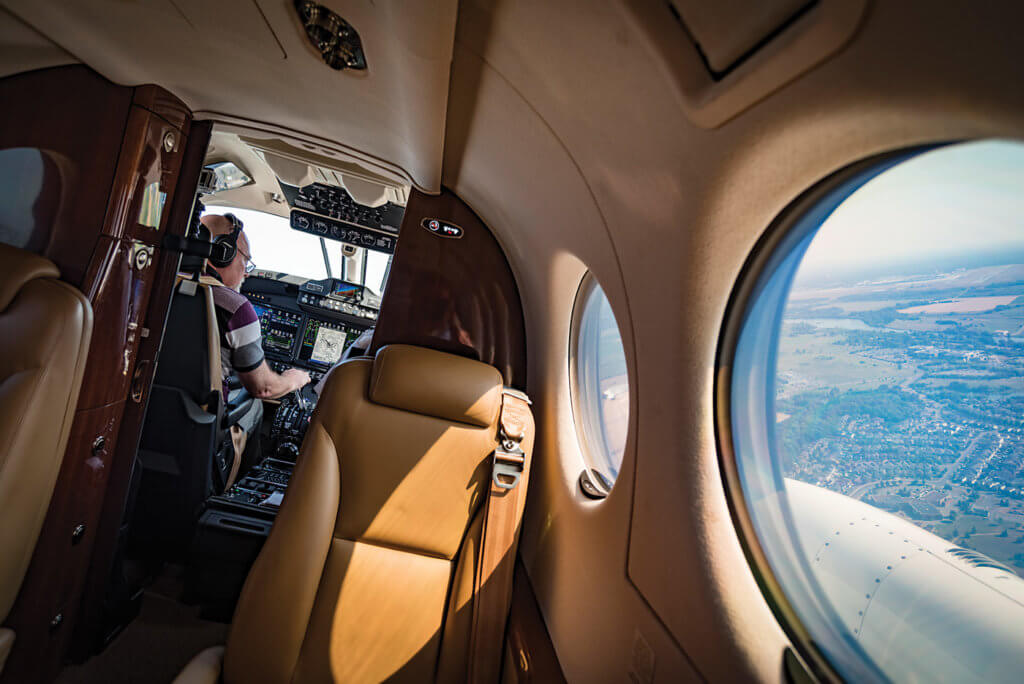
Touch is coming, but implementations vary as the technology matures. While Rockwell Collins provides touch displays, it’s worth noting that Garmin has taken a different tack with their G3000 and G5000 avionics systems, incorporating touch into separate control heads but not into the displays themselves… or at least not yet. Time will tell which system proves preferable.
I find that good measures of the utility of an avionics interface are the “intuition test” by unfamiliar fingers and also that it accommodates multiple ways of performing a specific task. Fusion passed on both counts.
Overall, Fusion’s touch capability offered new and often simpler ways of accomplishing routine cockpit tasks. Fusion touch delivers capability where it counts.
Robert Erdos is a contributing editor for Skies magazine. He is a professional test pilot with over 8,000 hours of flying experience on a wide variety of aircraft. A graduate of the U.S. Navy Test Pilot School, he is a former RCAF test pilot who now works as an experimental test pilot for the National Research Council in Ottawa. In his spare time, he does formation and airshow aerobatic flying as a pilot for Vintage Wings of Canada.
